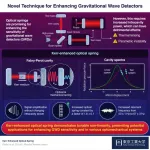(Press-News.org) The CHEOPS space telescope, whose scientific operations centre is based at the University of Geneva (UNIGE), is providing new information on the mysterious exoplanet WASP-76b. This ultra-hot giant is characterised by an asymmetry between the amount of light observed on its eastern terminator - the fictitious line that separates its night side from its day side - and that observed on its western terminator. This peculiarity is thought to be due to a ‘‘glory’’, a luminous phenomenon similar to a rainbow, which occurs if the light from the star - the ‘‘sun’’ around which the exoplanet orbits - is reflected by clouds made up of a perfectly uniform substance. If this hypothesis is confirmed, this would be the first detection of this phenomenon outside our solar system. This work, carried out in collaboration with the European Space Agency (ESA) and the University of Bern (UNIBE), is published in Astronomy & Astrophysics.
WASP-76b is an ultra-hot giant planet. Orbiting its host star twelve times closer than Mercury orbits our Sun, it receives more than 4,000 times the Sun’s radiation on Earth. ‘‘The exoplanet is ‘inflated’ by the intense radiation from its star. So, although it is 10% less massive than our cousin Jupiter, it is almost twice as big,’’ explains Monika Lendl, assistant professor in the Department of Astronomy of the UNIGE Faculty of Science, and co-author of the study.
Since its discovery in 2013, WASP-76b has been the subject of intense scrutiny by astronomers. A strangely hellish picture has emerged. One side of the planet is always facing its star, reaching temperatures of 2,400 degrees Celsius. Elements that would form rocks on Earth melt and evaporate here, before condensing on the slightly cooler night side, creating clouds of iron that drip molten iron rain.
The crucial contribution of CHEOPS
One of the most disturbing observations for astronomers is the asymmetry between the planet’s two terminators. The terminator is the imaginary line that separates the day and night sides of a planet. In the case of WASP-76b, the observations show an increase in the amount of light from the terminator to the east of the planet compared with the one to the west.
To solve this mystery, astronomers used no fewer than twenty-three observations with the CHEOPS space telescope, spread over three years. The ESA satellite, which is piloted by Switzerland and has its scientific operations centre at the UNIGE Department of Astronomy, observed numerous secondary eclipses of the planet (when it passes behind its star) and several phase curves (continuous observation during a complete revolution of the planet).
Combining these new data with those from other telescopes (TESS, Hubble and Spitzer), the astronomers were able to put forward a surprising hypothesis to explain the excess luminous flux on the eastern side of the planet: ‘‘This unexpected glow could be caused by a strong, localised and anisotropic reflection - i.e. one that depends on direction - what we call a glory,’’ explains Olivier Demangeon, researcher at the Instituto de Astrofísica e Ciências do Espaço in Portugal and lead author of the study.
A first outside our solar system
Glories are common phenomena on Earth. They have also been observed on Venus. The effect, similar to a rainbow, occurs when light is reflected by clouds made up of perfectly uniform droplets. In the case of Earth, the droplets are made out of water, but the nature of these droplets on WASP-76b remains mysterious. It could be iron, as this has already been detected in the planet’s extremely hot atmosphere. The detection of this phenomenon on WASP-76b is the first of its kind outside our solar system.
‘‘The reason why no such glory has ever been observed outside our solar system is that this phenomenon requires very specific conditions. First of all, the atmospheric particles must be almost perfectly spherical, completely uniform and sufficiently stable to be observed throughout a long time. These droplets have to be directly illuminated by the planet’s host star, and the observer - in this case CHEOPS - must be in the right position,’’ explains Olivier Demangeon.
Results to be confirmed
Further data will be needed to confirm with certainty that this intriguing excess of light on the eastern terminator of WASP-76b is a glory. This confirmation would attest to the presence of clouds made up of perfectly spherical droplets that have existed for at least three years, or that are constantly renewing themselves. For such clouds to persist, the temperature of the atmosphere would also have to be stable over time - a fascinating and detailed insight into what could be happening on WASP-76b.
Detecting such tiny phenomena at such a great distance will enable scientists and engineers to identify others that are just as crucial. For example, the reflection of starlight off liquid lakes and oceans - a necessary condition for habitability.
END
CHEOPS detects a ‘‘rainbow’’ on an exoplanet
New observations from the space telescope point to the existence of a «glory» in the atmosphere of WASP-76b, a luminous phenomenon like a rainbow
2024-04-05
ELSE PRESS RELEASES FROM THIS DATE:
UTSA joins consortium to create sustainable aviation hub in San Antonio
2024-04-05
(SAN ANTONIO, TEXAS) — UTSA has signed a memorandum of understanding (MOU) with the U.S. Department of Energy Advanced Research Projects Agency – Energy (ARPA-E), the City of San Antonio, and CPS Energy to develop and promote energy technologies that could potentially decarbonize the aviation sector. The ambitious project will pursue a range of research and development objectives, including sustainable aviation technologies, battery technologies and battery storage solutions, enhanced electric vehicle charging technologies and power-related technologies. The MOU will position San Antonio as an innovation center for these new energy solutions, accelerating their development ...
Kerr-enhanced optical spring for next-generation gravitational wave detectors
2024-04-05
The detection of gravitational waves stands as one of the most significant achievements in modern physics. In 2017, gravitational waves from the merger of a binary neutron star were detected for the first time which uncovered crucial information about our universe, from the origin of short gamma-ray bursts to the formation of heavy elements. However, detecting gravitational waves emerging from post-merger remnants has remained elusive due to their frequency range lying outside the range of modern gravitational wave detectors (GWDs). ...
Magnetic resonance imaging in prostate cancer screening
2024-04-05
About The Study: The results of this systematic review and meta-analysis suggest that integrating magnetic resonance imaging (MRI) in prostate cancer screening pathways is associated with a reduced number of unnecessary biopsies and overdiagnosis of insignificant prostate cancer while maintaining clinically significant prostate cancer detection as compared with prostate-specific antigen (PSA)-only screening.
Authors: Shahrokh F. Shariat, M.D., D.Dr.(hc), of Medical University Vienna in Vienna, is the corresponding author.
To access the embargoed study: Visit our For The Media website at this link https://media.jamanetwork.com/
(doi:10.1001/jamaoncol.2024.0734)
Editor’s ...
The sense of smell is influenced by cues from other senses
2024-04-05
The sense of smell is highly influenced by the cues from other senses, while the sense of sight and hearing are affected to a much lesser extent, shows a new study in Journal of Neuroscience.
A popular theory of the brain holds that its main function is to predict what will happen next, so it reacts mostly to unexpected events. Most research on this topic, called predictive coding, has only focused on what we see, but no one knows if the different senses, such as smell, work in the same way.
To figure out more about how smell relates to how we ...
RNA that doesn’t age
2024-04-05
Certain RNA molecules in the nerve cells in the brain last a life time without being renewed. Neuroscientists from Friedrich-Alexander-Universität Erlangen-Nürnberg (FAU) have now demonstrated that this is the case together with researchers from Germany, Austria and the USA. RNAs are generally short-lived molecules that are constantly reconstructed to adjust to environmental conditions. With their findings that have now been published in the journal Science, the research group hopes to decipher the complex aging process of the brain and gain a better understanding of related degenerative diseases.
Most cells in the human ...
Study finds many younger people from high income neighborhoods jumped the eligibility queue for COVID-19 vaccines in NYC
2024-04-05
Despite vaccine shortages, many younger people in New York City accessed vaccines ahead of schedule, particularly in high-income areas, according to new research at Columbia University Mailman School of Public Health. Low-income areas with high proportions of older people demonstrated lower coverage rates than wealthier areas in the first three months of vaccine rollout, and higher mortality over the year. The findings are published in the Journal of Urban Health.
“A vaccine program that prioritized those at greatest risk of COVID-19-associated morbidity and mortality would have prevented more deaths than the strategy that was implemented,” said Nina Schwalbe, adjunct ...
Rapid, simultaneous detection of multiple bacteria achieved with handheld sensor
2024-04-05
Hear the words E. coli or salmonella and food poisoning comes to mind. Rapid detection of such bacteria is crucial in preventing outbreaks of foodborne illness. While the usual practice is to take food samples to a laboratory to see the type and quantity of bacteria that forms in a petri dish over a span of days, an Osaka Metropolitan University research team has created a handheld device for quick on-site detection.
Led by Professor Hiroshi Shiigi of the Graduate School of Engineering, the team experimented with a biosensor that can simultaneously detect multiple disease-causing bacterial species within an hour.
“The palm-sized device for detection ...
Suicides among US college student athletes have doubled over past 20 years
2024-04-05
The number of suicides among US college student athletes has doubled over the past 20 years, finds an analysis of data from the National Collegiate Athletic Association (NCAA), published online in the British Journal of Sports Medicine.
Suicide is now the second most common cause of death after accidents in this group of young people, with rates highest among cross-country competitors, the findings show.
US suicide rates rose by around 36% across all age groups between 2001 and 2021, note the researchers. But the evidence ...
The Lancet: Prostate cancer cases expected to double worldwide between 2020 and 2040, new analysis suggests
2024-04-05
The Lancet: Prostate cancer cases expected to double worldwide between 2020 and 2040, new analysis suggests
Annual prostate cancer cases are projected to rise from 1.4 million in 2020 to 2.9 million in 2040, and annual deaths to increase by 85% to almost 700,000 over the same timeframe, mainly among men in low-and middle-income countries (LMICs).
The Lancet Commission on prostate cancer argues that the ‘informed choice’ programme for prostate cancer screening with PSA testing, which is common in high-income countries ...
Britain began industrializing in the 17th century – over a 100 years earlier than history books claim
2024-04-05
Britain was already well on its way to an industrialised economy under the reign of the Stuarts in the 17th century – over 100 years before textbooks mark the start of the Industrial Revolution – according to the most detailed occupational history of a nation ever constructed.
Built from more than 160 million records and spanning over three centuries, the University of Cambridge’s Economies Past website uses census data, parish registers, probate records and more to track changes to the British labour force from the Elizabethan era to the eve of World War One.
The research shows that 17th century Britain saw a steep decline ...
LAST 30 PRESS RELEASES:
American College of Cardiology comments on new dietary guidelines for Americans
American Society of Gene & Cell Therapy and Orphan Therapeutics Accelerator partner to advance and commercialize promising rare disease treatments
One in 14 patients having day case surgery have new or worse chronic pain 3 months after their operation
New study highlights link between eviction rates and gun violence
Heatwaves heat up soil but not toxin levels in rice, study finds
Digital modeling reveals where construction carbon emissions really come from
Turning farm waste into water filters
New study shows how the spleen helps the immune system accept a transplant
New Mayo Clinic study advances personalized prostate cancer education with an EHR-integrated AI agent
Researchers identify novel therapeutic target to improve recovery after nerve injury
Microbes in breast milk help populate infant gut microbiomes
Reprogramming immunity to rewrite the story of Type 1 diabetes
New tool narrows the search for ideal material structures
Artificial saliva containing sugarcane protein helps protect the teeth of patients with head and neck cancer
Understanding the role of linear ubiquitination in T-tubule biogenesis
Researchers identify urban atmosphere as primary reservoir of microplastics
World’s oldest arrow poison – 60,000-year-old traces reveal early advanced hunting techniques
Bristol scientists discover early sponges were soft
New study uncovers how rice viruses manipulate plant defenses to protect insect vectors
NSF–DOE Vera C. Rubin Observatory spots record-breaking asteroid in pre-survey observations
Ribosomal engineering creates “super-probiotic” bacteria
This self-powered eye tracker harnesses energy from blinking and is as comfortable as everyday glasses
Adverse prenatal exposures linked to higher rates of mental health issues, brain changes in adolescents
Restoring mitochondria shows promise for treating chronic nerve pain
Nature study identifies a molecular switch that controls transitions between single-celled and multicellular forms
USU chemists' CRISPR discovery could lead to single diagnostic test for COVID, flu, RSV
Early hominins from Morocco reveal an African lineage near the root of Homo sapiens
Small chimps, big risks: What chimps show us about our own behavior
We finally know how the most common types of planets are created
Thirty-year risk of cardiovascular disease among healthy women according to clinical thresholds of lipoprotein(a)
[Press-News.org] CHEOPS detects a ‘‘rainbow’’ on an exoplanetNew observations from the space telescope point to the existence of a «glory» in the atmosphere of WASP-76b, a luminous phenomenon like a rainbow





